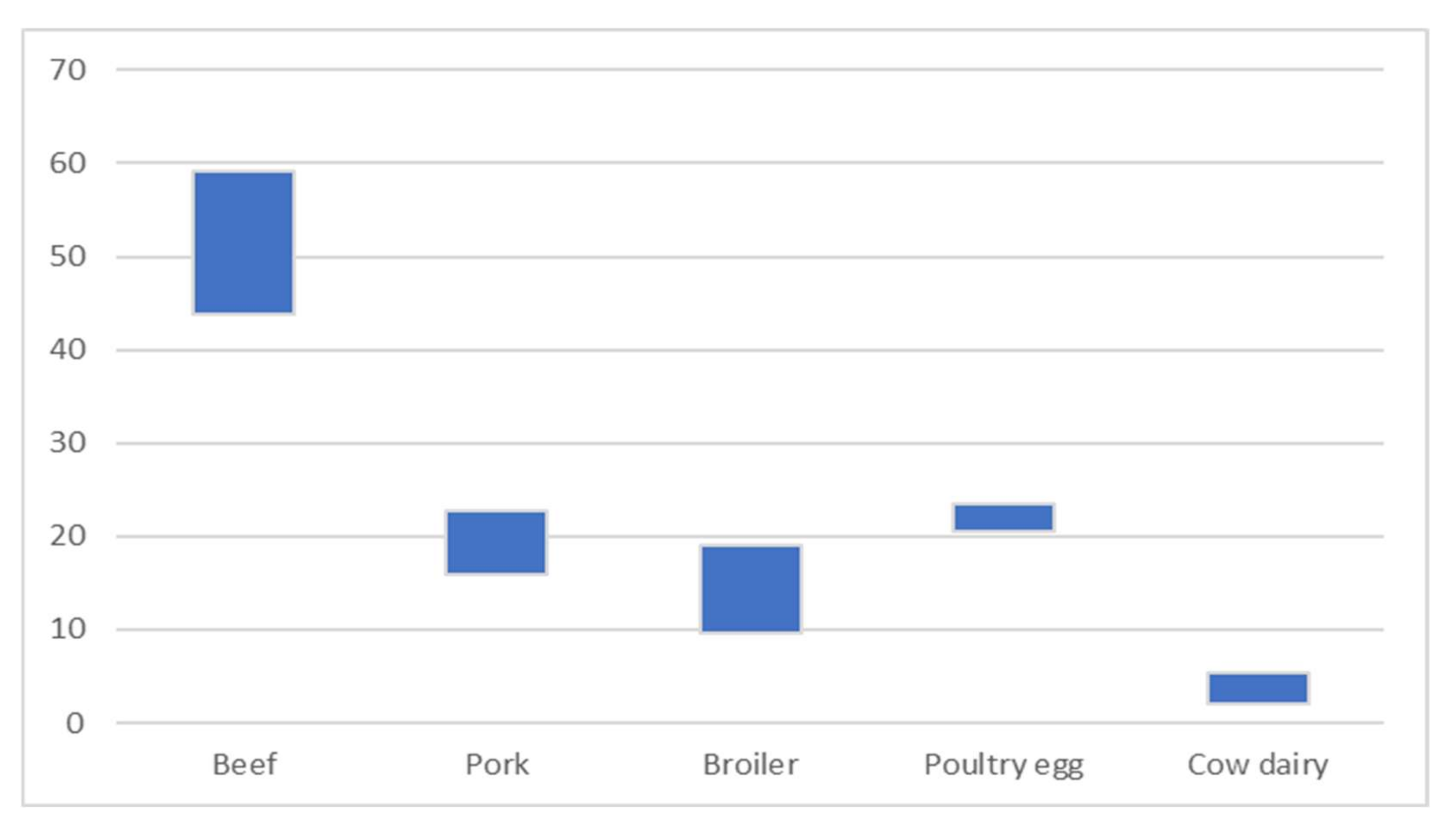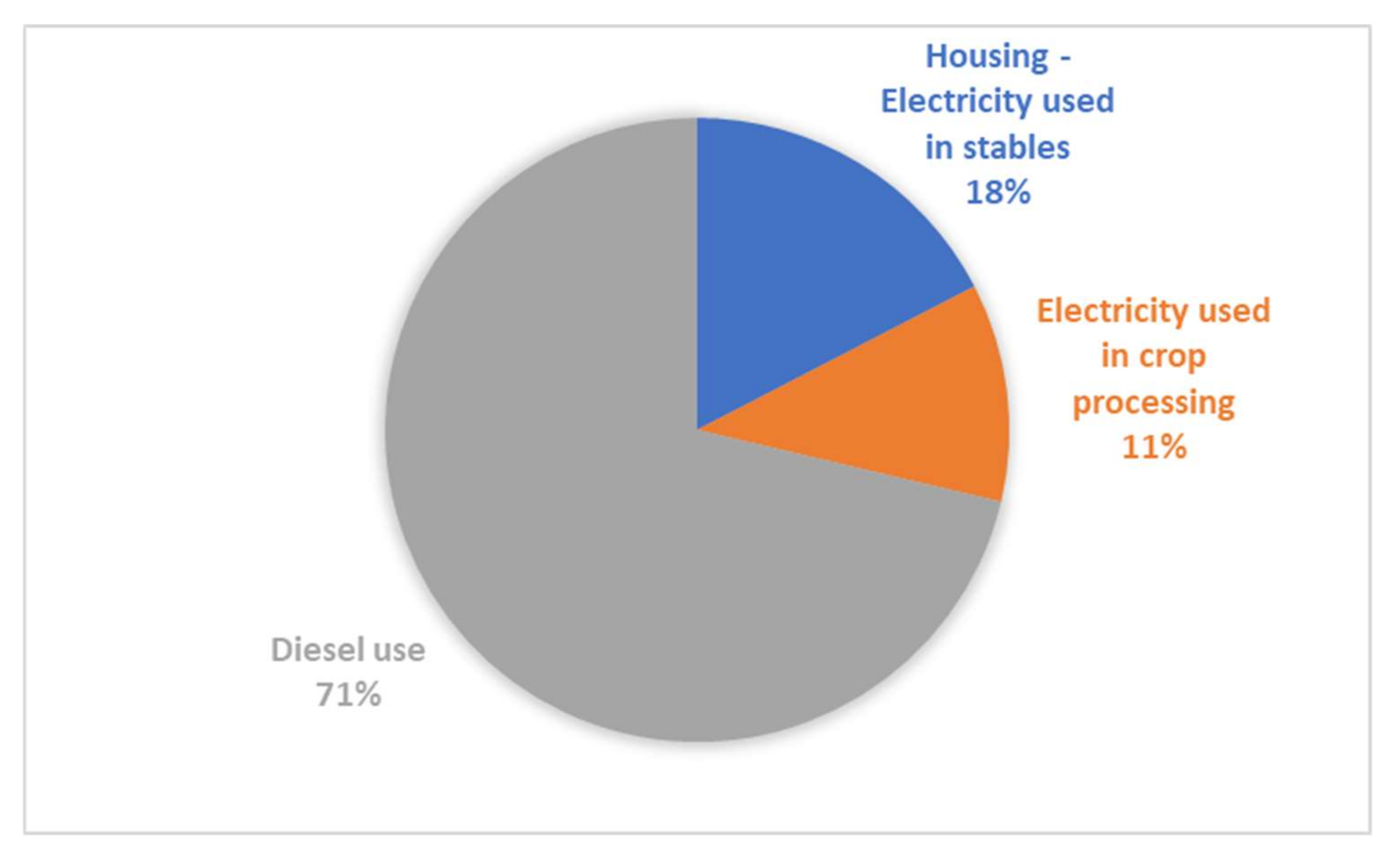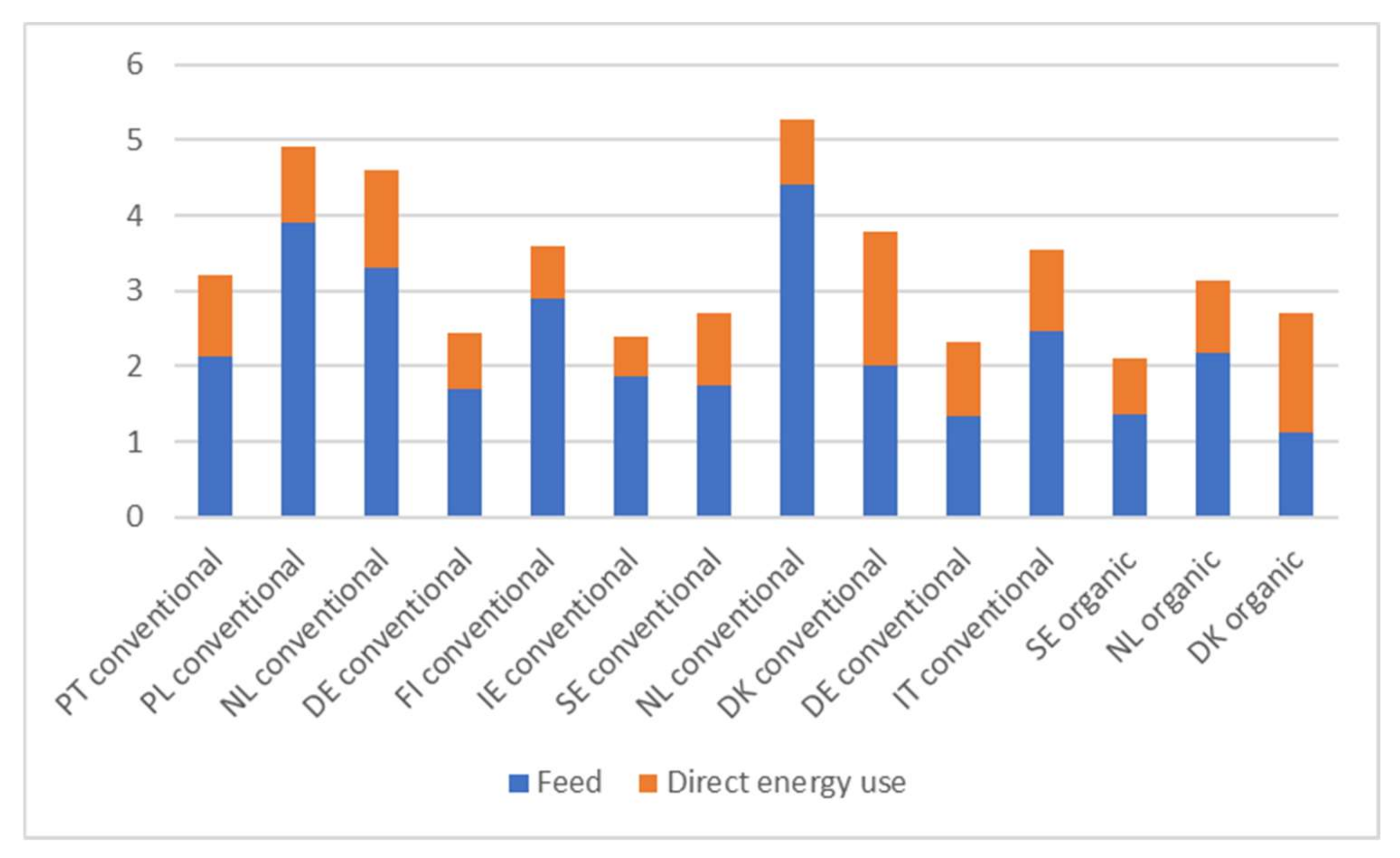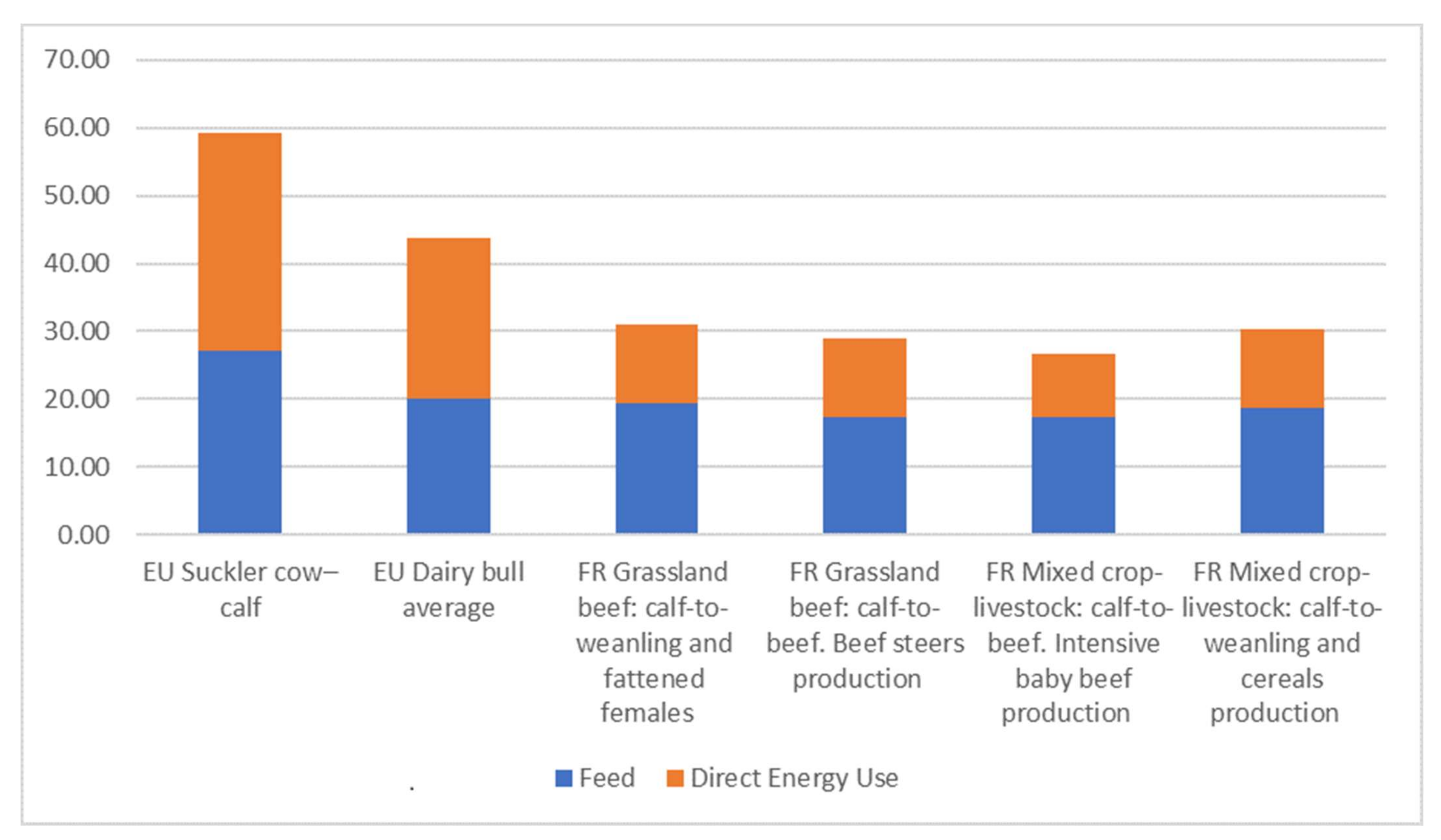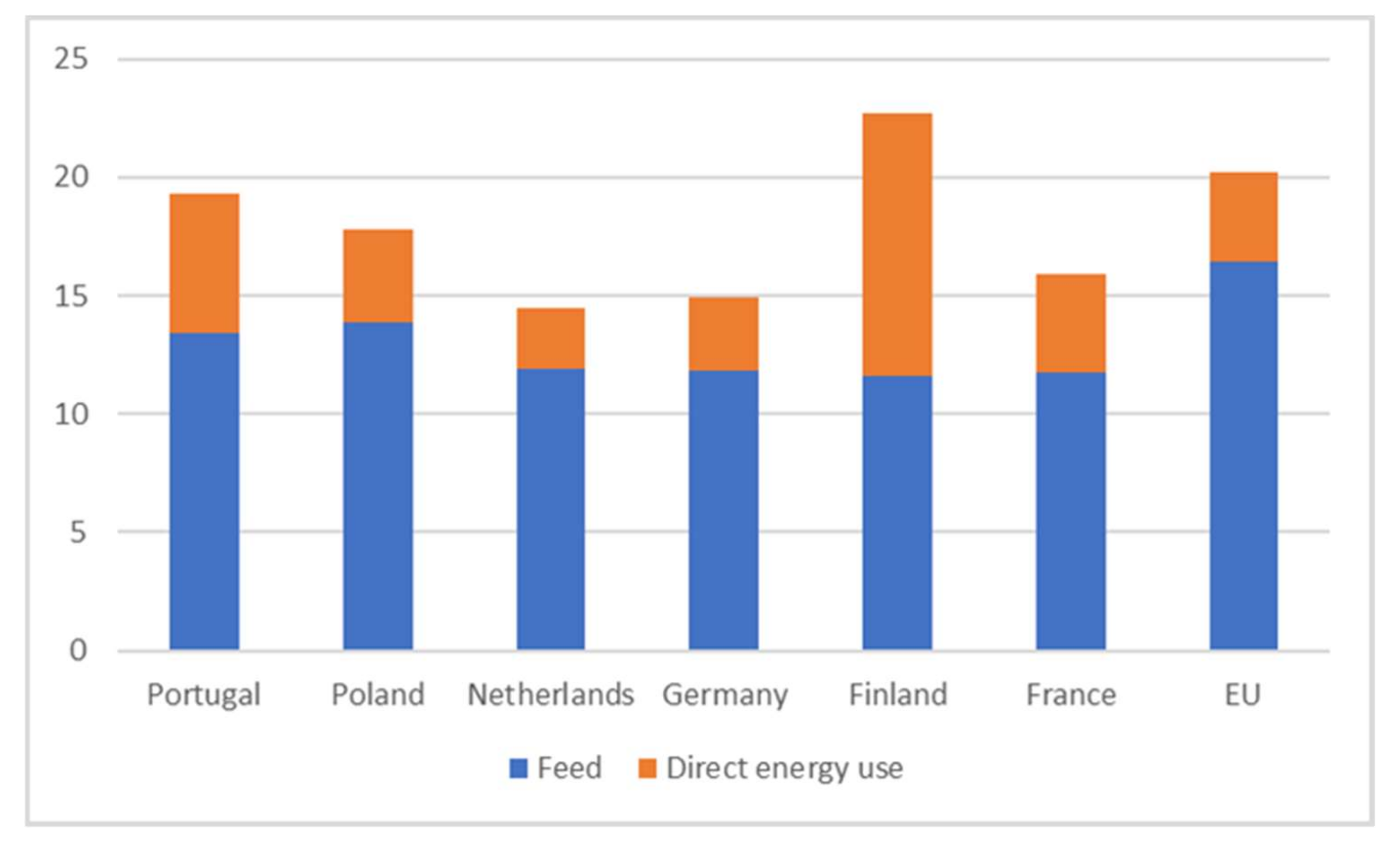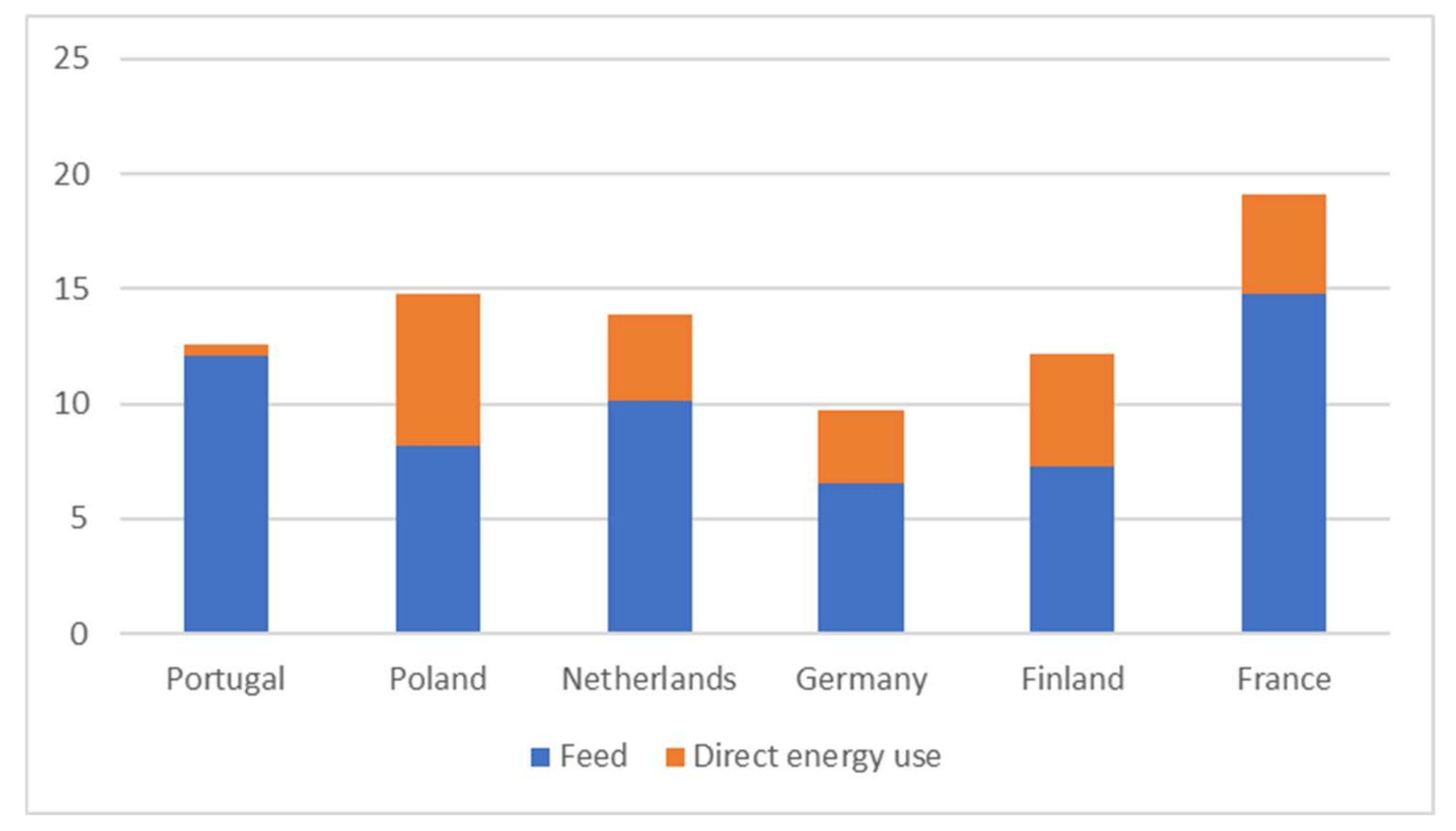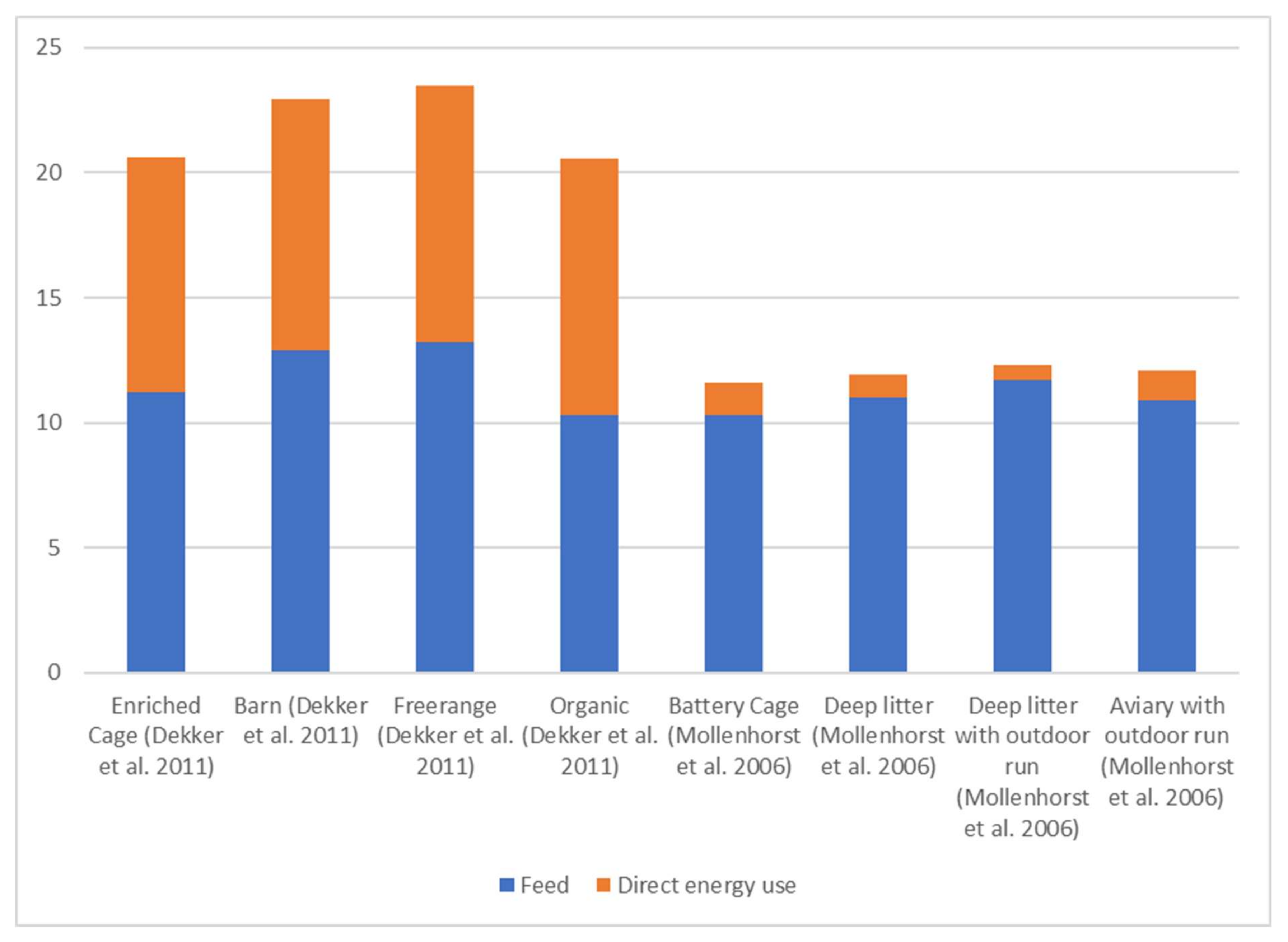1. Introduction
The EU livestock sector is a significant contributor to climatic change, a driver of land-use change, dependent on fossil energy sources, and a significant emitter of greenhouse gas (GHG) emissions [
1]. EU member states have significant livestock populations, with more than half of all agricultural holdings (5.7 million) keeping livestock, while the annual value of livestock products is €170 billion. Based on data from 2018, the main livestock populations in the EU consisted of 148 million pigs, 87 million bovine animals, and 98 million sheep and goats [
1,
2], while the main outputs of the livestock sector are meat and milk products.
Significant data are available on a European level on the production levels, production patterns [
2,
3], and financial accounts of livestock [
4] held in the EU. However, relatively little information is available on the energy use associated with livestock production in the EU as a whole and for specific livestock categories. In recent years, national and EU policy is increasingly focused on improving environmental sustainability and animal welfare of livestock production, and in order to achieve the goals set out in the Green Deal and the Farm to Fork strategy, livestock rearing, and production will need to transform in the coming decades [
5]. For the development and implementation of these goals, a clear understanding of energy use concentrations in the livestock sector in production systems and across production stages is a prerequisite.
Eurostat, Faostat, and individual member states provide data on energy use in agriculture, collected through surveys, but not specific livestock sectors [
3,
6]. Certain studies look at particular aspects related to energy use and livestock production, including Costatino et al. (2016) [
7], who investigate the energy use for climate control in livestock housing in Europe, Weiss and Leip (2012), who investigated greenhouse gas emissions from the EU livestock sector [
8], Ramirez and Blok (2006), who investigated the energy requirements associated with creating one pound of meat in four European countries [
9], Veermäe et al. (2012) provide an overview of energy consumption in animal production [
10], and De Vries and De Boer (2010) compared the environmental impacts through a number of life-cycle assessments (LCAs) in the livestock sector [
11].
In addition, a range of individual studies has been published in recent years, mainly as LCAs, investigating energy use on individual farms in specific agroecological contexts and providing data on the energy embedded in animal feed as well as direct on-farm energy use [
12,
13,
14,
15,
16,
17,
18,
19,
20,
21,
22,
23,
24,
25]. These include studies that investigated the environmental impacts of beef production systems [
12,
20,
23], pig production systems [
13,
14,
18,
22], poultry meat and egg production systems [
15,
19], and milk production systems [
23,
24,
25], as well as smaller livestock production systems, such as sheep and goat [
16,
17]. Similarly, there are a number of publications that focus on the production and use of animal feed, which highlights that 60-70% of European farmland is used to produce feed for livestock [
10,
26,
27,
28].
Simultaneously, there have been a number of important trends in EU livestock farming in recent decades that affect energy use. These include intensification, whereby livestock farming is increasingly characterized by larger farms and higher livestock densities [
29], increased use of breeding techniques (breed substitution, cross-breeding, and within breed selection) [
30], increased dependence on imported animal feed, and in recent years, there is a notable shift, driven by both supply and demand factors, towards alternative and more sustainable production techniques based on organic principles and the adoption of fossil-energy-free strategies and technologies (FEFTS) [
30,
31,
32,
33,
34,
35].
A review bringing together insights and data from these studies in an accessible manner is necessary. In this context, the goal of this paper is to provide a review of energy use in the EU livestock sector by bringing together data from a range of studies. The rest of this section provides a brief description of a conventional livestock system in the EU (specific systems for specific livestock categories are discussed in more detail in the Results section),
Section 2 presents the methodology for this review,
Section 3 presents the main results from our review, and
Section 4 provides a wider discussion.
Livestock systems and their energy use in the EU show significant variation and are affected by a variety of factors, including geography, production systems, and agroecological zones [
7,
9]. There are, however, a number of important generalizations regarding energy use concentrations, which are described in more detail per livestock category in the Results section.
In most production systems and livestock categories, animal feed is the main energy-consuming input [
36,
37]. Within the EU, about a third of total manufactured animal feed is compound feed; other ingredients are artificial forages (approximately 50%) and direct-fed raw materials (approximately 20%). In addition, a significant share of feed comes from pasture, estimated to be around 940 million tonnes [
38]. According to the EU, 77% of total feed consumption is produced domestically; feed production accounts for around 60% of total wheat, maize, and barley consumption. Despite this, the EU livestock sector is dependent on imported protein sources for livestock feed. It is estimated that the EU has a deficit of about 70% of high-protein materials, of which 87% is met by imported soybean and soymeal [
39]. The EU imports 18.5 million tonnes of soybean meal every year, of which 95% goes towards feeding animals [
40].
Energy inputs in the production of animal feed are dominated by the production of fodder crops and the associated indirect energy inputs, including fertilizers, pesticides, seeds, and feed supplements [
8]. Many existing studies provide figures on the energy use associated with the production of animal feed; these, however, show significant variation depending on origin, raw material use, and livestock system [
27]. The production, processing, and transportation of these feeds require a significant amount of energy inputs, which are mostly dependent on fossil sources, and represent a large proportion of the total energy consumed in livestock production. From the data covered in this article, the proportion of feed (concentrates, conserved forage, or grazing) makes up more than 50%, and in many cases 75% or more, of the total energy consumption within livestock sectors.
In most systems, livestock is kept in animal housing, but significant variation is reported in terms of energy use depending on the structures used, the agroclimatic conditions, and the types of livestock used [
7]. Generally, these systems offer some sort of climatic control of the indoor spaces, and the main energy-consuming categories are heating, cooling, ventilation, lighting, and a range of other devices [
7]. In dairy systems, specifically, significant energy consumption is allocated to milking processes [
24,
41].
Manure management occurs in a variety of forms depending on the structure of the farm. Manure is generally collected and stored for a period of time in specific storage tanks that can be located underneath or close to the housing system. Various methods exist for moving the manure, such as via conveyor belts, through slated floors, or tractors. During the storage stage, or later, the manure is treated and most usually applied to land at a later stage [
41,
42].
2. Materials and Methods
2.1. Selection Criteria, Search Strategy, and Data Collection
This study conducts a meta-analysis based on the Preferred Reporting Items for Systematic Reviews and Meta-Analysis (PRISMA) in order to conduct a critical review of the energy use in the livestock sector. In order to be included in this paper, studies needed to meet a number of criteria set out by PRISMA. All studies needed to be peer-reviewed, published, and, when relevant, based on detailed LCA methodologies using one of the main LCA software and up-to-date database values. In a few cases, reports were also considered if they were widely cited, publicly available, and published by well-reputed organizations. Our search strategy followed a number of pre-set steps; the relevant studies were identified through keyword searches through SCOPUS and google scholar, while partners in the AgroFossilFree consortium were also requested to provide relevant studies. Studies were then screened for relevance, and data were only extracted/used if the methodology and results were comparable to other LCA studies. Due to this, over half of the identified studies were discarded due to a lack of a detailed breakdown of energy inputs. Instead, they provided only aggregate energy use figures with little or no methodological justification. In total, 22 papers were included in this review. This process also highlighted that different methodologies assess energy use using different parameters and categorizations, which are often not comparable to one another.
Energy use data were retrieved from each study and compiled. These data were then compared to other existing studies for verification. This process was chosen to account for the scarcity of accurate energy use data. Comparing the main findings of screened LCA studies with other studies placed results in a wider context, allowing for the identification of patterns and the comparison between different approaches and systems. In addition, this process facilitates the identification of future areas of research.
An operational definition of energy use in the livestock sector was adopted for this study, including energy from both direct and indirect sources. The boundary of this study was all energy used until the farm-gate. Direct energy use refers to all energy that is consumed in the production of livestock that happens on the farm. The direct energy sources included in this study were energy for all on-farm operations and machinery use, crop processing and feeding, milking processes (milking and milk cooling), manure handling, and animal housing (lighting, heating, cooling, dehumidifying, and ventilation). Indirect energy sources refer to energy that is associated with the production of livestock but is consumed prior to the farm. The indirect energy sources included in this study were the production of fertilizers, pesticides, and energy used in animal feed (includes all the energy used to produce animal feed, including for its raw materials). In practice, almost all studies provide data on animal feed as indirect energy sources. Energy use associated with the production of agricultural buildings, equipment, and machinery was not included; this approach was chosen as many studies do not include these data in their energy use data. In addition, there are considerable issues with measuring this agricultural infrastructure accurately as it is often assigned to other sectors, such as industry, and due to the long-time frame associated with the use of this agricultural infrastructure. Our results section presents these results; for a more detailed data breakdown per livestock category and sources, please see the
Appendices A and B.
Conceptually, this study investigated energy use in the largest livestock sectors in the EU, including bovine (beef and milk), swine/pig meat, and poultry (meat and eggs). Other livestock sectors, including sheep and goat, are mentioned briefly but not discussed in detail due to a lack of sufficient reliable data; these are identified as areas for future research.
2.2. Bias Risk and Limitations
There are a number of bias risks within and across studies. By focusing mainly on LCAs, emphasis was placed on specific studies that investigated energy use in livestock systems within an individual or a small collection of farms in particular production systems and agroclimatic conditions. However, a variety of other factors, including policy, social factors, knowledge, input and output prices, all influence on-farm energy use. There are a number of additional important limitations associated with this study. Data are presented without degrees of uncertainty as LCAs generally do not provide data with uncertainty attached. The main drawback is that due to the nature of LCAs and the lack of uncertainty, it was difficult to transfer these results and use them for estimates for other farms.
A major drawback of investigating energy use in agricultural systems in general, including livestock, is that there is no standardized methodology for measuring energy use on-farm and within the food system. As such, different studies allocated energy use according to different categories, which made comparisons difficult. For instance, some studies provided aggregate figures for housing as a whole, while others provided breakdowns for different housing aspects. These limitations were largely addressed through the screening process. In addition, by focusing on LCAs, other methodologies for measuring energy use were not included. Additionally, data from minor and alternative livestock production systems were not included by focusing on conventional livestock production systems. Focusing on these sectors is an area for future research.
5. Conclusions
In conclusion, the results from the studies included in this review indicated that energy use was concentrated in feed, housing, and manure management. In most systems, animal feed was the dominant energy use category. This suggests that energy use in livestock systems is underreported as the majority of energy use associated with feed happens off the farm and is not attributed to the livestock sector in official agricultural statistics.
Regarding specific livestock categories, the studies covered indicated that the energy use requirements range from 2.1 to 5.3 MJ/kg per ECM for cow milk, 59.2 MJ/kg for a suckler cow–calf, and 43.73 MJ/kg for a dairy bull, 15.9 MJ/kg to 22.7 MJ/kg for pork production, 9.6 MJ/kg to 19.1 MJ/kg for broiler production, and 20.5–23.5 MJ/kg for chicken egg production. Our review indicated a reliance on fossil energy sources and discussed the transition toward more energy-efficient livestock systems and a higher dependence on renewable energy sources.
Our analysis indicated the need for a standardized methodology in measuring energy use in livestock systems. We see this as a necessary step to develop interventions that reduce fossil energy use and livestock contribution to climatic change. In addition, various other areas have been identified for future research, including other livestock categories and an investigation into the relationship between energy use and agroclimatic conditions as well as farm size.
